Sanyo VPC-G210 digicam – the start of something big
My first foray into digital photography
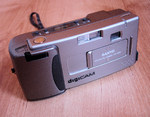 It’s 1997 and the evolution of digital cameras continues unabated, as manufacturers try to cram more pixels into pictures to produce better quality images. Since the earliest LCD consumer camera first appeared, the 1995 ¼VGA Casio QV-10 that I describe elsewhere, digicams were jostling for position with film cameras and there’d be an insatiable demand for higher resolution, more memory, faster operation, improved battery life and more camera-like features and controls.
It’s 1997 and the evolution of digital cameras continues unabated, as manufacturers try to cram more pixels into pictures to produce better quality images. Since the earliest LCD consumer camera first appeared, the 1995 ¼VGA Casio QV-10 that I describe elsewhere, digicams were jostling for position with film cameras and there’d be an insatiable demand for higher resolution, more memory, faster operation, improved battery life and more camera-like features and controls.
Film still had the edge by a long mile, especially amongst purists, and it would be another decade before digital cameras were considered as serious replacements for film SLRs; a decade later in 2007 I eventually invested in a Sony Alpha SLR that I imported from B&H Photo in New York (the best online service I ever had – ordered late one Sunday night, it arrived Wednesday morning).
Originally (say 1992-1997), I relied on film for photographing my electronic projects, websites and magazine articles, using a lovely Minolta X-700 SLR with 50mm macro lens and ring flash, though I briefly used a Minolta Vectis APS film camera in between times. I’d send exposed film to my publishers for developing at their local chemist, and then black and white prints would be scanned in for magazine page composition by the in-house typefit bureau.
This work regime was costly, inflexible and most of all very time consuming. As pressure on my workload increased, it became obvious that ‘digital’ was the way ahead as it would vastly improve productivity all round, giving me lots more flexibility to take shots and view the results instantly.
The magazine would have to get used to me sending loads of JPEGs instead of rolls of 35mm Kodak film, and for my part I’d have to start sending my work ‘down the wire’, using a direct modem-to-modem terminal program (Procomm Plus for Windows) to upload my stuff onto their Amstrad PC in the typefit bureau office. (It would be some years before we adopted Internet-based comms for file transfer using email instead; for one thing, we didn’t trust the Internet’s reliability.)
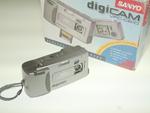 I’d kept an eye on the nascent digital camera market and eventually I plumbed for one of the next generation VGA models, a Sanyo VPC-G210. At the time, this model was highly regarded for having a better quality LCD screen than its rivals, one that was brighter and faster to react with hardly any ‘lag’. I purchased it from Dixons in July 1997, for a grand total of £550. (I still recall how Dixons tried flogging me an extended warranty because ‘the screens are the same as a laptop’ and when I declined they said ‘Oh, you’re a gambler, then.’)
I’d kept an eye on the nascent digital camera market and eventually I plumbed for one of the next generation VGA models, a Sanyo VPC-G210. At the time, this model was highly regarded for having a better quality LCD screen than its rivals, one that was brighter and faster to react with hardly any ‘lag’. I purchased it from Dixons in July 1997, for a grand total of £550. (I still recall how Dixons tried flogging me an extended warranty because ‘the screens are the same as a laptop’ and when I declined they said ‘Oh, you’re a gambler, then.’)
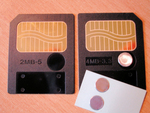 Smart Media flash memory cards from the 1990s. The cropped corner denoted the voltage. 5V are extremely rare to find these days. The metal foil sticker was for write-protection!The Sanyo VPC-G210 showed how digicams specifications and features were rapidly improving, as it also had a built-in flash and removable media, namely a 3.3V Smart Media slot (making earlier 5V types obsolete in the process). Usefully, it also had an optical viewfinder and a self-timer as well. A slide switch could be set for close-up ‘macro’ photography – classed as being in the range of 20-50cm!
Smart Media flash memory cards from the 1990s. The cropped corner denoted the voltage. 5V are extremely rare to find these days. The metal foil sticker was for write-protection!The Sanyo VPC-G210 showed how digicams specifications and features were rapidly improving, as it also had a built-in flash and removable media, namely a 3.3V Smart Media slot (making earlier 5V types obsolete in the process). Usefully, it also had an optical viewfinder and a self-timer as well. A slide switch could be set for close-up ‘macro’ photography – classed as being in the range of 20-50cm!
What’s more, the Sanyo could record voice memo sound clips and actually take movies! These ‘multi shot’ sequences were recorded as 1/16th of the normal frame size in either 0.1s or 0.2s intervals, a total of 16 sub-images in all. They could either be ‘played back’ on the camera, or viewed using the bundled PC software (see later). You could even play them back on a TV for presentations, via the A/V lead and SCART adaptor included. This feature was especially appreciated by some users.
Downloading images onto a PC involved a slow serial RS-232 lead or – better - a Smart Media card reader on a USB port instead. Remember that USB in this era was brand new and terribly slow, with USB1.1 offering a paltry 12Mpbs per second, but it was light years ahead of anything we’d seen before then.
Another card-reading option was a so-called ‘Flashpath’ adaptor, which was a coin-cell powered floppy-disk shaped thing; you inserted the memory card into it and slotted the adaptor into a PC’s floppy drive. It worked after a fashion, but was chronically slow, needing Windows 98 drivers to make it work and the contraption still cost me £50, which was typical of the money-sinking pit that this branch of technology would turn into.
Once images were saved to hard disk, they could be manipulated with early imaging programs included JASC Paint Shop Pro (now owned by Corel) or Adobe Photoshop if you could afford it.
Digital fun at the funfair
Digital cameras were still a very rare sight on the streets at that time, and it would be a few months before I ventured out with mine, taking my mum to visit a funfair one evening in December 1997. Your average Joe hadn’t really seen a digital camera before, and the sight of me waving this strange silvery box around was met with a little bemusement. On the downside, the camera was a pretty heavy lump (12 ozs./ 360g) to lug around, but also it had an appetite for batteries, and it scoffed four AA cells for lunch. I’d bought a 16-pack of AA’s from Dixons, which lasted me no time at all.
Here are a few original night-time funfair photos from 1997 (click to see).
Exploring Sanyo Multi Shot ‘movie clips’
In a separate blog I make these Sanyo mini 16-frame movies into an animated .gif, using a macro for PaintShop Pro to semi-automate the process.
In time for Teach-In 98
Generally digital camera technology was showing a lot of promise though, and then the magazine commissioned me to co-write Teach-In 98 – An Introduction to Digital Electronics along with Ian Bell, Tony Wilkinson and Rob Miles. Part One of this tutorial series would be appearing in November 1997’s issue, so it was all hands on deck as we started writing the text and the practical ‘Lab Work’ solderless breadboard experiments.
Ian, Tony and Rob drafted the academic parts while I concentrated mainly on the practical lab experiments. It was for Teach-In 98 that my new digital camera came into its own, transforming my productivity and workflow.
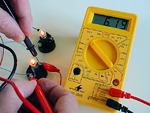 We started off badly because the typesetter, the late Terry Farmilowe, was confounded by these new digital images which he claimed had a resolution of ‘only’ 72 dpi and he wouldn’t change the tick-box in Photoshop at his end to accommodate them. Instead I had to change it to 300 dpi – but it was only a number, otherwise still the same image, same pixels and same resolution!
We started off badly because the typesetter, the late Terry Farmilowe, was confounded by these new digital images which he claimed had a resolution of ‘only’ 72 dpi and he wouldn’t change the tick-box in Photoshop at his end to accommodate them. Instead I had to change it to 300 dpi – but it was only a number, otherwise still the same image, same pixels and same resolution!
There were some obvious quality differences between these and film, and although it probably took everybody a little time to accept digital images, the benefits outweighed the drawbacks and they were good enough to get things going. There would be no turning back, and my new digital camera was immediately and hugely beneficial, especially when putting together Teach-In 98’s ‘Lab Work’ practical experiments.
At long Iast I could assemble and test out the circuits on a solderless breadboard and photograph them instantly. And of course, if I didn’t like the images I could re-shoot them there and then, a new option that came like a breath of fresh air. Here are a few Teach-In 98 original images for old time's sake (click to see full size original VGA):
^ Some original Teach In 98 images
As busy as a PhizzyB
The PhizzyB ‘Physical Beboputer’ by Clive Maxfield was a work of genius, a computer tutorial that had an accompanying hardware trainer hooked to a PC serial port. The software was also on the magazine’s first ever cover-mounted CD-ROM (I used to design all their cover disks, and never had a single problem).
The Sanyo digicam would be pressed into service once again when I was asked to help with the PhizzyB magazine series – Max and Alvin handling the theory side while I handled out their practical experiments from November 1998’s issue as described here.
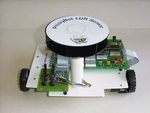 Upgrading to a Ricoh 1280 px was needed for the PhizzyB series [click to see]
Upgrading to a Ricoh 1280 px was needed for the PhizzyB series [click to see]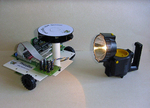 Another higher res 1280 px image of the PhizzyBotThere was terrible pressure on my time as I also had to source some parts, but the Sanyo digicam was of tremendous help in starting the series, though I used my Minolta film camera to shoot the main PhizzyB board, to get the required detail. Digital image quality was proving inadequate enough, though, and it was time to upgrade to a 1280 x 960 px Ricoh to complete the PhizzyB experiments.
Another higher res 1280 px image of the PhizzyBotThere was terrible pressure on my time as I also had to source some parts, but the Sanyo digicam was of tremendous help in starting the series, though I used my Minolta film camera to shoot the main PhizzyB board, to get the required detail. Digital image quality was proving inadequate enough, though, and it was time to upgrade to a 1280 x 960 px Ricoh to complete the PhizzyB experiments.
 The Sanyo VPG-G250 was 25% smaller than the G210 with a higher resolution screen and menusThere’s no doubt the Sanyo digicam played an important role in helping my work to evolve and grow. Sanyo updated this model to the VPC-G250 which was 25% more compact and used just two AA cells. It still used Smart Media cards but was smarter and menu-driven on a higher resolution LCD, a great improvement on its clunky predecessor.
The Sanyo VPG-G250 was 25% smaller than the G210 with a higher resolution screen and menusThere’s no doubt the Sanyo digicam played an important role in helping my work to evolve and grow. Sanyo updated this model to the VPC-G250 which was 25% more compact and used just two AA cells. It still used Smart Media cards but was smarter and menu-driven on a higher resolution LCD, a great improvement on its clunky predecessor.
As we entered the 2000s it was evident how indispensable digital photography was becoming, especially in the trendy ‘new media’ market of web design when I could (at last) take instant photos and upload them onto the web, without needing to shoot film and then use a flatbed scanner for the prints. They were very happy, productive and satisfying times, and there was no doubt the ‘digital still camera’ was here to stay.
The Sanyo was also the start of a costly and ceaseless upgrade path, as I would update to a Ricoh megapixel model (RDC-4200, Smart Media, 1280 x 960 px), and then a Ricoh RDC-5300 (1792 x 1200 px), though I still used a tough Minolta Vectis APS film SLR camera for my Pipelines to Pylons project (1999). A Fuji S602 digital ‘bridge’ camera was sourced in the mid 2000s, which has an excellent 1cm macro that I still use today (ideal for some web and magazine work).
I eventually rented a small photostudio but my photography career finally ended with a Sony (was, Minolta) Alpha SLR and macro lens etc, mostly all now dispensed with. These days I use several 7.2MP Sony Cybershot DSC-P200 digicams for snapshots; its Carl Zeiss lens can still produce remarkable results and they're picked up cheaply on eBay.
Exploring Sanyo Multi Shot ‘movie clips’
In a separate blog I've shown how to make these Sanyo mini 16-frame movies into an animated .gif, using a macro for PaintShop Pro to semi-automate it.
What a great time it was to be alive!


 Thursday, April 18, 2024 at 9:53PM
Thursday, April 18, 2024 at 9:53PM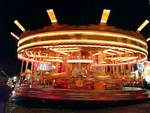
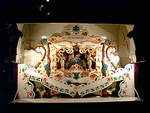
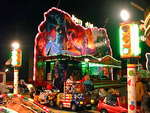
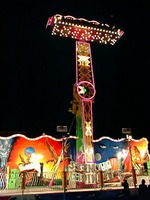
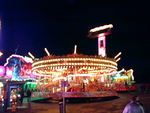

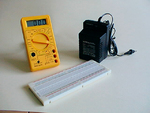
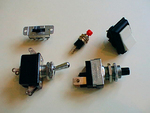
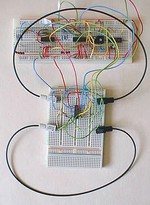
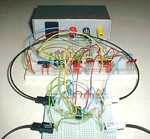
Reader Comments